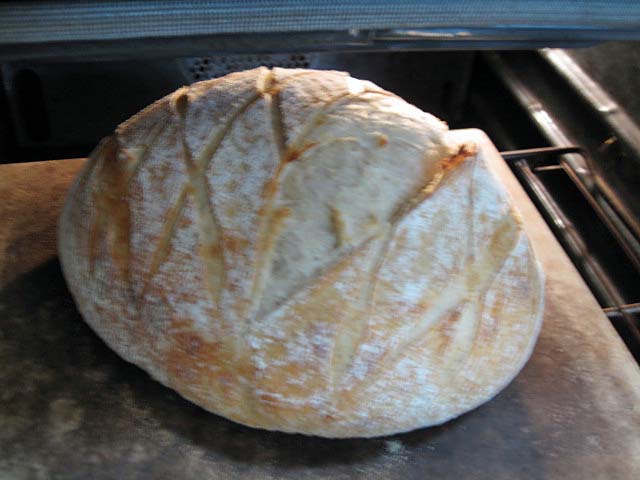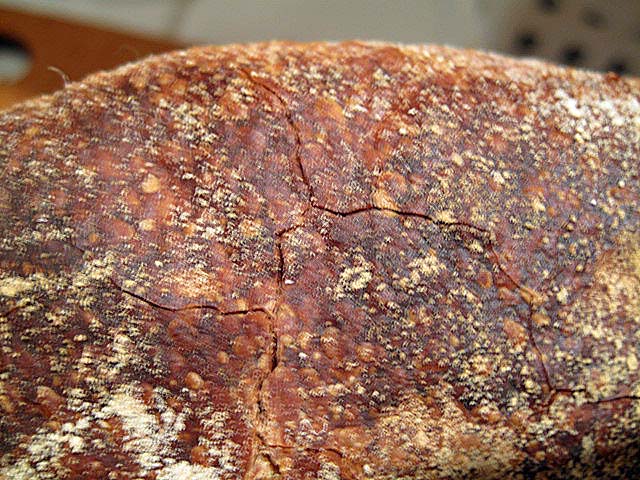
One of the breads we baked at the SFBI Artisan II Workshop last month was a miche. Everyone thought it was one of the best breads we baked. I made it at home for the first time two weeks ago, but used “Organic Type 85” high-extraction flour from Central Milling rather than the mix of white and whole wheat with the addition of toasted wheat germ we had used at SFBI. (See This miche is a hit!)
This bread was delicious, but I did want to make it at least once using the formula we had used at the SFBI, just to see how it turned out at home compared to baked in a commercial steam injected deck oven. Certainly the several TFL members who have baked this miche in their home ovens since I posted the formula have found it to be good. Also, at the SFBI, we had found that miches scaled at 2.5 to 3 kg somehow had an even better flavor than those scaled at 1.25 kg. So, today I baked a 2 kg miche using the original SFBI Artisan II formula.
For those who would like to make this larger version, here is the formula for a 2 kg miche:
|
Total Dough
|
Bakers %
|
Weight (g)
|
|
AP Flour
|
96.67
|
1087
|
|
WW Flour
|
3.33
|
38
|
|
Water
|
73.33
|
824
|
|
Salt
|
2
|
23
|
|
Wheat germ toasted
|
2.5
|
28
|
|
Total
|
177.83
|
2000
|
|
Pre-ferment
|
Bakers %
|
Weight (g)
|
|
AP Flour
|
75
|
112
|
|
WW Flour
|
25
|
38
|
|
Water
|
100
|
150
|
|
Salt
|
0
|
0
|
|
Liquid starter
|
50
|
75
|
|
Total
|
250
|
375
|
|
Final Dough
|
Bakers %
|
Weight (g)
|
|
AP Flour
|
100
|
975
|
|
Water
|
69
|
675
|
|
Salt
|
2
|
23
|
|
Wheat germ toasted
|
2.5
|
28
|
|
Levain
|
31
|
299
|
|
Total
|
204.5
|
2000
|
The procedure used was the same as in my previous blog entry about this bread with one exception – shooting for a slightly lighter crust, I baked with steam for 20 minutes at 450ºF, then turned the oven to convection bake at 425ºF for another 40 minutes. I did not leave the miche in the turned off oven to dry out before removing it to the cooling rack. I did leave it in the oven while I heated the oven back up to 460ºF conventional bake for the next loaves (about 5 minutes).
I was concerned about over-proofing this loaf, and it was lined up ahead of a couple San Joaquin Sourdough breads waiting to bake.

Miche after baking 20 minutes with steam at 450ºF
The blowout I got suggests the loaf was a bit under-proofed. I also shaped the boule really tight, which may well have been a second factor.
The miche sang loud and long while cooling. The crust had some crackles, but not like the last miche.

Crust crackles

Loaf profile, cut through the middle

Crumb

Crumb close-up

2 kg miche beside 514 g San Joaquin Sourdough bâtards
The crust was crunchy-chewy - much thinner than the last bake. It was much less caramelized, and this was apparent in the less wonderful crunch and flavor. The crumb was nice. It was quite noticeably denser in the center of the loaf. I think this is expectable with a miche of this size. I thought the crumb structure was pretty consistent from the center of a slice to the crust.
6 hours after baking: The aroma of the crumb had a pronounced whole wheat grassiness. The crumb was moderately chewy. From past experience, I expect it to be softer tomorrow. The flavor was good - mildly sour with a nice wheaty flavor - but I didn't enjoy it quite as much as the miche made with Central Milling's "Type 85" flour. I think the flavor would have been better had I used fresh-milled whole wheat. That's what I will do the next time I bake this miche.
24 hours after baking: The aroma and flavor have mellowed and melded. The grassy aroma is gone. It just smells like a good sourdough country bread. The flavor is now delightful - very complex - nuttier and sweeter. A very thin smear of unsalted butter makes this bread ambrosial.
I froze half the miche. The other half will be croutons for onion soup gratiné tonight, breakfast toast with almond butter and crostini with ribollita for dinner tomorrow. (The ribollitta was my wife's all-morning project.) That should leave another quarter loaf for sandwiches, panini, French toast ...
David
Submitted to YeastSpotting